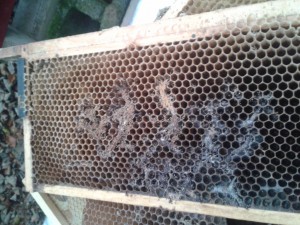This is the time of year for scraping down the stack of equipment that got thrown into the shed during the active season – I know this because that’s what I’ve been doing this afternoon. Once started I realise why it takes so long to get down to it because it really isn’t nice. Not nice at all.
There should be a course -‘Entomology for Beekeepers’ because the assortment of creepy crawlies to be found in the detritus at the bottom of a beehive is bewildering and horrifying – like Doctor Who with maggots.
Among these horrible occupants is a lot of wax moth and by wax moth I really mean the larvae and pupae of the lesser wax moth Achroia grisella which live on beeswax and pollen. Badly infested frames are wreathed in cobweb-like shrouds left by the larvae as they tunnel through the combs. In corners and in any crevices lurk the pupae which are very hard to remove and they seem able to embed and even glue themselves into the wood!

Wax moth are more often found in brood frames – they don’t like supers especially if they are stored wet – ie not given back to the bees to clean after extraction because 1. they don’t like honey and 2. they need the old bee coccoons and pollen in their diet and they are mostly to be found in the brood frames.

To store supers wet – stack on an old floor and a queen excluder to prevent mice then place a couple of sheets of newspapers between each super then top off with another queen excluder and a sheet of plywood or some other solid lid. Also, bear in mind – wax moth don’t like the light and they don’t like the cold so if you have somewhere light and airy and cold that will deter them too.
But back to the scraping. Where the frames are old and the combs black, it is best to just jettison the wax: break it out and use it for firelighting but scrape down the frame to re-wax in the spring. Where the combs and the frames are in reasonable condition (apart from the moth) and so long as the wax is not actually crumbling away to dust with the infestation, scrape them down and apply Certan before storing away. Certan is a spray-on biological ‘cure’ containing a bacteria which seeks out and destroys wax moth larvae. There are no implications for the bees or the honey – which is always nice.
Alternatively fumigate with acetic acid. Click here for instructions on how to do that thing.
A massive population of wax moth can lead to a population explosion in the creatures that eat them which should be good but isn’t really. I’m talking spiders here – those whoppers with hairy legs and death heads on their tee-shirts. Cor they really give you the willies those things.
Since the advent of mesh floors I think there is less wax moth than there used to be as there is much less hive-floor debris for them to wriggle about in – but they haven’t gone away you know. A blow torch is great for getting into the hive corners where your hive tool won’t reach and it is so satisfying to roast the little feckers.
However in the wild, wax moth will seek out and demolish the combs in abandoned nests, some which may have died of American Foul Brood… A case of nature pressing the reset button.
Copyright © Beespoke.info, 2014. All Rights Reserved.